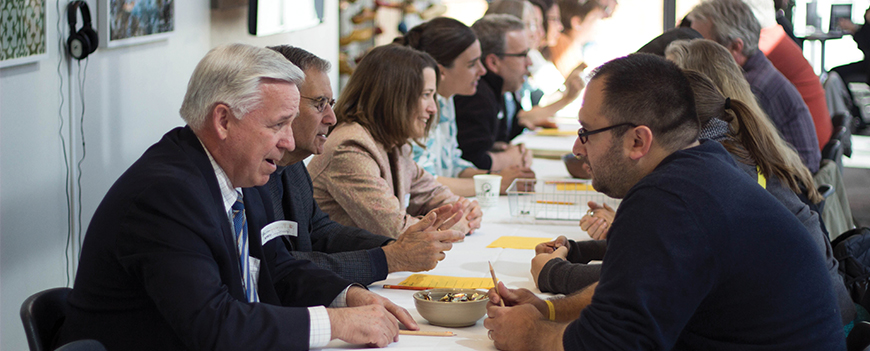ArtsySTEM Symposium adds art and science speed dating to panels
Scientifically-minded individuals sat across from artistically-minded people Friday and got to know each other, speed-dating style.
But instead of trying to find the perfect date, this speed dating activity was designed to provide artists and scientists a place where they could network and share different ideas and discuss distinct ways of thinking.
“It gives a space for two groups of people who maybe don’t otherwise have cause to be in the same room talking about their ideas, you know, to come together,” said Adriane Dalton, the assistant curator at the Norra Eccles Harrison Museum of Art.
The speed dating activity was part of the symposium for the exhibit ARTsySTEM: The Changing Climates for the Arts and Sciences. ARTsySTEM is part of a larger series at Utah State University, integrating art with the STEM branches of science, technology, engineering and math.
“The symposium has a lot of visiting scientists who have interest in art and do art projects or artists who have interest in science and do science art projects,” said Brooke Jacques, a junior in graphic design. “It’s a really cool intersection of art and science.”
Throughout the semester, ARTsySTEM has been holding a series of lectures from visiting and residential artists who are using a combination of both subjects to bring about social awareness and environmental change, especially around the subject of climate change.
“The climate change is an actual issue, and … art and science are finding a function in real world issues and the relevance that it has in our life,” said Darren Bingham, a junior in environmental studies. “I think art does things that others can’t, so I really enjoy the connective-ness with the topics.”
Mikey Kettinger, who is pursuing his master’s degree in art, said that even though there is a lot of scientific data regarding issues like climate change, there is not a lot of radical change as a response.The role of artists can be to present projects in a way that is more appealing to a broader spectrum of people by bringing humor and interactive art to the information expressed.
“Because such drastic change is needed on such a giant scale, we have to try something else,” Kettinger said. “We have to try something new. We have to try integrative approaches so that people will start to care.”
Art and science are often regarded as two separate — even opposite — fields of study. Art is considered a more right-brained activity and science a left-brained activity, Bingham said. This produces different mentalities and approaches to communicating with others.
“We’ve done a really go job of compartmentalizing our careers and individualizing and separating ourselves from everyone else,” Bingham said, “and this is a great example of how people might see not just how abstract science and art are to each other, but how there’s so much connectivity and intertwining in it.”
Jacques agreed.
“Most people think of them as completely opposite ends of the spectrum, completely different subjects — which they are, but there’s a lot to be gained from putting them together,” she said. “You get new ideas and new projects that wouldn’t otherwise be there, and I think it adds a lot to both worlds when you combine them.”
For scientists and artists looking to collaborate on a project, finding someone to work with is as simple as reaching out and calling someone interested in the subject for the project, Kettinger said.
“I think there’s sort of a misconception that artists want to be working alone in the corner, and like, taking all the credit and just doing everything by their self,” Kettinger said. “I’m interesting in collaborating with scientists or with historians or with anybody who has an interesting idea.”
More information about ARTsySTEM or other events that integrate art and science can be found on social media like Facebook, Twitter and Aggie Radio, which hosts a show every Thursday at 4 p.m. called Aggies Going Green that focuses on sustainability and environmental care.
The museum exhibit will also be open until August 1. NEHMA is open Tuesday through Saturday 10 a.m.- 5 p.m.
“Art is for everyone, and science is for everyone,” Bingham said, “It really doesn’t matter what your degree is. You can find collaboration anywhere.”
ARTsySTEM is scheduled to return in the spring of 2017.
— miranda.lorenc@gmail.com

